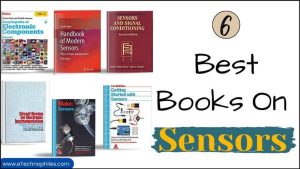Last updated on February 8th, 2025 at 12:21 pm
Sensors are used in several instruments in various fields. May it be your mobile phone, car, or complex MRI and CT scan machines. Sensors are part of all. this must have caught your interest since you are looking for the best books on sensors. For curious minds like yourselves, we have hand-picked these 6 best books on sensors:
List of 6 best books on sensors
Which is the best overall book on sensors? (Our pick)
The overall best book on sensors is Handbook of Modern Sensors: Physics, Designs, and Applications by Jacob Fraden . The book covers basic physical principles, including thermodynamics, electromagnetism, and optics. As well as applications of sensors in areas such as automotive engineering, medical diagnostics, and security.
The use of real-world examples to illustrate the key concepts makes this book an invaluable resource for anyone interested in learning about this rapidly evolving field.
Which is the best overall book for beginners? (Our pick)
The best book on sensors for beginners is Make: Encyclopedia of Electronic Components: Sensors by Charles Platt . It covers a wide range of topics, from the basics of sensor physics to the latest developments in nanotechnology.
The detailed explanations of how sensors work and how they are used in everything from medical devices to video games, give beginners a profound knowledge of the field of sensors.
Make: Encyclopedia of Electronic Components
This is the only encyclopedia you will find in the market that is dedicated to sensors. It will provide you with all the knowledge you need to know about electrical components (sensors).
Key Features:
- Understand the working, functions, and variants of sensors
- Contains numerous photographs, diagrams, and schematics
- Learn about light, sound, heat, motion, ambient, and electrical sensors
- Easy-to-navigate index
- Specific explanations on troubleshooting are covered within the book
Ideal for: Students, Teachers, Hobbyists, and Engineers
Not ideal for: Children
Number of pages: 258
Number of chapters: 41
Handbook of Modern Sensors: Physics, Designs, and Applications
If you want to learn what a specific sensor does, how it operates, its basics to modern applications, the physics behind the operation, etc. then you should buy this book.
Key Features:
- Includes designs, principles, and practical implementations
- Learn about sensing technologies in mobile devices
- Dedicated chapter on chemical sensors
Ideal for: Students, Researchers, Applied Physicists, Engineers, and Technicians
Not ideal for: Children
Number of pages: 777
Number of chapters: 19
Circuit Design For Electronic Instrumentation
If you are looking for an all-around book on electronics. Then this is an ideal choice. It will explain sensors in detail along with other components included in analog and digital instruments.
Key Features:
- Biological and medical instruments
- Filled with graphs, tables, and figures
- Helpful for Wobshall’s open-book exams
- Various other electronic devices included
Ideal for: Engineering Students
Not ideal for: Beginners
Number of pages: 390
Sensors and Signal Conditioning
If you want to learn application-based aspects then this book is ideal for you. It covers the most advanced and widely used sensors in the market.
Key Features:
- Focus on velocity, chemical, and fiber-optic sensors
- 100+ end-of-chapter problems
- 68 worked examples for a better understanding
- A dedicated section on microsensor technology
Ideal for: Advanced Engineering Students and Technicians
Not ideal for: Beginners
Number of pages: 608
Number of chapters: 9
Make: Getting Started with Sensors
Learn to use it in conjunction with Arduino and Raspberry Pi with this book. See how both can be integrated to build real-world projects.
Key Features:
- Connect your projects to the internet with Raspberry Pi or Arduino
- Use Arduino to develop sensor systems
- Build sensor projects with the Linux-powered Raspberry Pi
Ideal for: Hobbyists and Engineers
Not ideal for: Readers who can’t program with Raspberry Pi or Arduino
Number of pages: 215
Number of chapters: 10
Make: Sensors
Learn how to use sensors to monitor the physical world. Do it with the help of Arduino and Raspberry Pi. The authors have done a great job of stating the integration of the two.
Key Features:
- Make the least complex and low-power brain for your sensor with Arduino
- Learn about touch, light, accelerometers, gyroscopes, magnetic, temperature, humidity, and gas sensors
- Perform additional processing with Linux-based Raspberry Pi
- Fully colored book with illustrations, tables, and charts in appropriate places
Ideal for: Engineers and Technicians
Not ideal for: Beginners
Number of pages: 402
Learning about sensors is made easy with this list of books. The Make: Encyclopedia of Electronic Components: Sensors by Charles Platt is a must-have on your shelf. It is a one-of-a-kind book (encyclopedia) for beginners available in the market.
If you have some basic knowledge of sensors and an understanding of electronic circuits then you should go for the Handbook of Modern Sensors: Physics, Designs, and Applications by Jacob Fraden. It is a great read for anyone who wants to build something with sensors.












